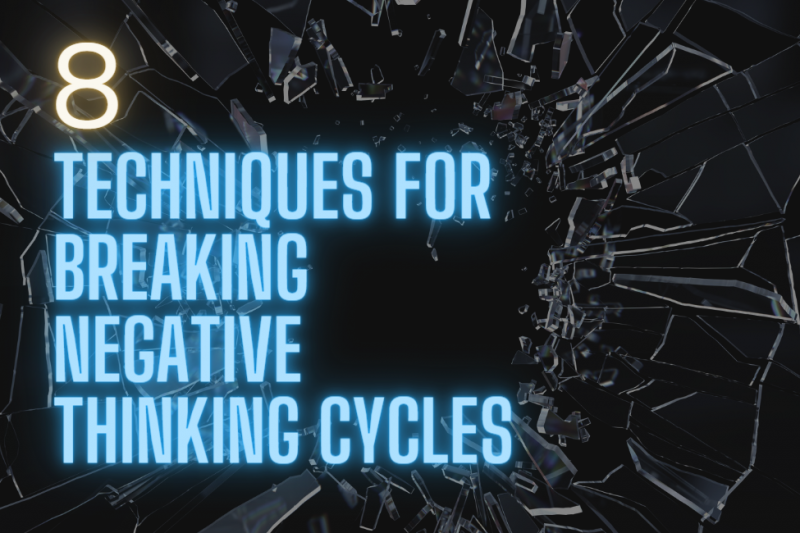Introduction
You’re stuck in a rut of negative thinking, aren’t you? It’s a tough place to be. But don’t worry, you’re not alone. This guide is here to help.
We’ll explore eight effective strategies to break those pesky negative thought cycles. From mindfulness meditation to regular gratitude practices, you’re about to discover how to foster a positive mindset that’ll significantly transform your life.
Ready to get started? Let’s dive in!
Understanding Negative Thought Patterns
Before you can break free from negative thinking cycles, you’ve got to understand what these patterns look like in your own life. It’s not always easy to spot, but you’ve likely experienced them in forms of self-doubt, fears, or even harsh self-criticism. You might find yourself constantly dwelling on past mistakes, or worrying excessively about future outcomes.
Once you’ve identified these patterns, you’ve got to be proactive. Don’t let the negative thoughts take control. Challenge them. Ask yourself: Is this thought truthful? Is it helpful? You’ll find that most of your negative thoughts don’t hold up under scrutiny.
Remember, it’s not about completely eliminating all negative thoughts. That’s not realistic. It’s about learning to manage them effectively. You’ve got to learn how to dispute irrational thoughts and replace them with more constructive ones. This is a skill, and like any skill, it takes time and practice to master.
Focusing on Mindfulness Meditation
Let’s turn our attention to mindfulness meditation, a powerful tool in your journey towards a positive mindset.
You’re going to discover the essentials of this practice, its numerous benefits, and get an overview of various techniques.
Mindfulness Meditation Basics
Your journey to a positive mindset can start with mastering the basics of mindfulness meditation. This practice involves focusing your attention on the present moment, accepting it without judgment. It’s a powerful tool that can help you break the cycle of negative thinking.
Start by finding a quiet place where you won’t be disturbed. Sit comfortably, close your eyes, and take deep, slow breaths. As you breathe in and out, focus on the sensation of your breath. If your mind starts to wander, that’s okay. Gently bring your attention back to your breath.
Don’t expect perfection. It’s normal to get distracted, especially when you’re starting. It’s the act of returning your focus that builds mindfulness. Keep practicing, and you’ll soon notice a shift towards a positive mindset.
Benefits of Mindfulness
Numerous benefits come with practicing mindfulness meditation, significantly reducing your negative thinking cycles. It allows you to become more aware of your thoughts, helping you to identify and deal with negative patterns effectively. You’ll likely experience reduced stress, improved concentration, and better emotional well-being. Regular mindfulness meditation can also enhance your self-esteem and decision-making skills. It can even help you sleep better and boost your immune system.
However, it’s not just about reaping benefits. It’s about making a long-term commitment to yourself. Mindfulness meditation isn’t a quick fix, but a lifestyle change. By incorporating it into your daily routine, you’re investing in your mental health. You’re taking a proactive approach to breaking your negative thinking cycles, and that’s a step towards a more positive mindset.
Meditation Techniques Overview
Mindfulness meditation, a powerful tool you can use, involves various techniques designed to cultivate a heightened state of awareness and focused attention.
You start by finding a quiet place and sitting in a comfortable position.
It’s important to close your eyes and focus on your breathing, observing each inhale and exhale without judgment.
You can use a mantra or a mindful object if that helps you concentrate.
If your mind wanders, don’t get frustrated. Just acknowledge the distraction and gently bring your focus back to your breath.
It’s about being fully present in the moment, not trying to empty your mind.
Practice regularly, and you’ll find it easier to break negative thinking cycles and maintain a positive mindset.
The Power of Positive Affirmations
In spite of the challenges you face, harnessing the power of positive affirmations can dramatically shift your mindset towards optimism and resilience. Positive affirmations are powerful, concise statements that you repeat to yourself, designed to foster a positive mindset and change your self-perception. They’re not just feel-good quotes or motivational sayings, but practical tools that can help reshape your subconscious thoughts.
Consider the power of repeating something like, ‘I am capable, strong, and resilient’ during a stressful day. This affirmation, while simple, has profound psychological effects. By consistently reinforcing this belief, you’re training your mind to view yourself in a positive light, even when times are tough.
But remember, positive affirmations work best when they’re personal, realistic, and meaningful to you. Avoid generic phrases that don’t resonate with your experience. You’ve got to truly believe in the affirmation for it to make an impact.
Benefits of Physical Activity
Another powerful tool you’ve got in your arsenal for combating negative thoughts is physical activity, which provides an array of mental health benefits. When you’re physically active, your body releases chemicals called endorphins that trigger positive feelings, helping to elevate your mood. This natural mood booster can be just the ticket for breaking free from the cycle of negative thinking.
Exercise also acts as a great distraction, allowing you to shift your focus from negative thoughts to the activity at hand. Whether it’s running, yoga, or dancing, physical activity demands your attention, leaving less room for unwanted thoughts.
Additionally, regular exercise can help you sleep better, reducing anxiety and stress. A good night’s sleep enhances your mood, aids in memory and concentration, and bolsters your overall mental wellbeing. Moreover, the confidence gained from achieving fitness goals can improve your self-esteem and body image, further reducing negative thoughts.
Remember, it’s not about becoming a marathon runner overnight. Start small, and gradually increase the intensity and duration of your workouts. Stay consistent, and you’ll soon notice a shift in your mindset.
Nurturing Healthy Relationships
You can’t underestimate the power of nurturing healthy relationships when you’re trying to break free from negative thinking. Surrounding yourself with positive, supportive people directly influences your outlook on life. It’s essential to cultivate relationships that make you feel good about yourself, that lift you up rather than pull you down.
The first step is to identify the negative influences in your life. Are there people who often criticize you, belittle your achievements, or continually focus on the negatives? If so, it might be time to re-evaluate these relationships. You don’t need to cut people out of your life entirely, but setting boundaries can be a healthy choice.
Next, make an effort to spend more time with those who inspire and uplift you. These are the people who’ll support your journey to a more positive mindset. Engage in activities you enjoy together, have meaningful conversations, and be there for each other.
Embracing Self-Compassion
Now, let’s turn our focus to embracing self-compassion. Understanding this concept, along with practicing self-kindness, can bring a myriad of benefits to your mental health.
You’ll see how being kinder to yourself can change your thought patterns and foster a more positive mindset.
Understanding Self-Compassion
Amidst the journey towards a positive mindset, embracing self-compassion is a crucial step you can’t afford to miss.
Self-compassion isn’t about feeding your ego or being selfish. It’s about understanding your emotions, accepting your flaws, and forgiving yourself for mistakes. It’s treating yourself with the same kindness and patience you’d show to a good friend.
You’re human and it’s okay to stumble, to have bad days, to struggle. Don’t beat yourself up over these moments. Instead, practice self-compassion. Speak to yourself with kindness, remind yourself that everyone has tough times, and remember to take care of your own needs.
With self-compassion, you can break negative thinking cycles and foster a more positive mindset.
Practicing Self-Kindness
Embracing self-compassion begins with practicing self-kindness, a critical step in shattering negative thought patterns. It’s about treating yourself with the same care and respect you’d give a loved one. You need to be patient with yourself, understanding that everyone makes mistakes, and it’s part of the learning process. Recognize your imperfections, celebrate your achievements, and don’t beat yourself up over failures.
When you stumble, don’t dwell on it. Instead, pick yourself up and try again. This practice can help you break the cycle of negative thinking. It’s essential to remember that you’re a work in progress. By practicing self-kindness, you’ll nurture a more positive mindset, enhancing your overall well-being and resilience.
Benefits of Self-Compassion
When you start embracing self-compassion, you’ll notice a significant shift in your mental and emotional well-being. You’ll find that you’re less critical of yourself and more understanding of your flaws. This self-kindness can foster a more positive mindset, breaking the cycle of negative thinking.
What’s more, self-compassion can help you handle stress better. Instead of beating yourself up over a mistake, you’ll learn to treat yourself with the same kindness you’d extend to a friend in the same situation. This nurturing attitude can lead to improved resilience and mental health.
Plus, self-compassion can boost your self-esteem and confidence, paving the way for personal growth. Embrace self-compassion, it’s a powerful tool for positive change.
The Role of Balanced Nutrition
In your journey towards a positive mindset, remember that a balanced diet plays a crucial role in breaking negative thinking cycles. When you’re well-nourished, you’re more capable of managing stress, staying focused, and maintaining a positive outlook.
Your brain, like any other organ, needs quality fuel to function properly. Eating meals filled with fruits, vegetables, lean proteins, and whole grains can boost your mood and energy, allowing you to face life’s challenges with a clear mind and a healthy perspective. If you’re constantly loading up on junk food, you’re not giving your brain the nutrients it needs to combat negative thoughts.
Also, let’s not overlook the importance of hydration. Dehydration can lead to fatigue and irritability, which can exacerbate negative thinking. So, make sure you’re drinking plenty of water throughout the day.
Practicing Gratitude Regularly
One powerful technique you can’t overlook is regularly practicing gratitude. It’s about acknowledging the good things in your life, big or small. This simple act can shift your focus from what’s wrong to what’s right, thereby breaking the cycle of negative thinking.
Make it a habit to list down at least three things you’re thankful for each day. You might be surprised at how this simple routine can quickly change your perspective. You’ll start to see the positives in your life more clearly, and the negatives will seem less overwhelming.
Writing in a gratitude journal can be a great start. It allows you to reflect on your day and recognize the good things that happened. Even on your worst days, you’ll find there’s always something to be grateful for.
Practicing gratitude also encourages a positive outlook. You’ll tend to expect good things to happen, which can lead to a more optimistic mindset. This doesn’t mean you’ll ignore the negatives, but you’ll be better equipped to deal with them.
Frequently Asked Questions
How Can Medication or Therapy Contribute to Breaking Negative Thinking Cycles?
Medication and therapy can help you break negative thinking cycles by addressing the root causes. They can stabilize mood swings, alleviate anxiety, and boost your overall mood.
Therapy, specifically, equips you with coping strategies to combat negative thoughts and implement positive ones. So, you’re not just tackling the symptoms, but also working on long-term solutions.
Can Childhood Experiences Influence Our Current Negative Thought Patterns?
Absolutely, your childhood experiences can shape your current negative thought patterns. It’s often the case that early life events, both positive and negative, mold your perception of the world.
If you’ve had a tough childhood, you might be more prone to negative thinking. But remember, you’re not doomed to this mindset. You can break this cycle and cultivate a positive outlook, it just takes some work and perhaps professional help.
Can Positive Thinking Techniques Help With Severe Mental Health Disorders Such as Depression or Anxiety?
Yes, positive thinking techniques can help with severe mental health disorders like depression or anxiety. You’re not alone in this struggle and learning to shift your mindset can be beneficial.
Strategies like mindfulness, meditation, and cognitive-behavioral techniques can provide relief. It’s important to remember, though, that while these methods can aid in your recovery, they’re not a substitute for professional help.
Don’t hesitate to seek a mental health professional’s advice.
How Much Time Should I Dedicate Daily to These Techniques for Optimal Results?
You’re wondering how much time to dedicate daily to certain techniques? It varies among individuals, but generally, dedicating about 20-30 minutes a day can yield positive results.
It’s not about cramming in hours, but consistent, daily practice. You’re rewiring your brain, after all.
Remember, it’s okay to start small and gradually increase. You’re building a habit, not running a sprint.
Patience and persistence are key.
Are There Any Specific Books or Resources That Can Help Me Further Understand and Practice These Techniques?
Absolutely, there are many resources that can deepen your understanding and practice of positive thinking techniques.
Books like ‘The Power of Positive Thinking’ by Norman Vincent Peale and ‘You Are a Badass’ by Jen Sincero are great places to start.
Additionally, apps such as Headspace or Calm offer guided practices.
Remember, it’s not about quantity, but consistent, daily practice.
You’re on a great path to conquering negative thoughts.
Conclusion
Breaking negative thinking cycles isn’t easy, but it’s possible. Start by understanding your thought patterns.
Then use techniques like mindfulness meditation and positive affirmations.
Keep active, nurture healthy relationships, and practice self-compassion.
Don’t forget the importance of a balanced diet and regular gratitude practice.
It’s a journey, but remember, every step you take towards a positive mindset is a step closer to a happier, healthier you.
You’ve got this!





